1998 CHEVROLET PRIZM brake light
[x] Cancel search: brake lightPage 126 of 364
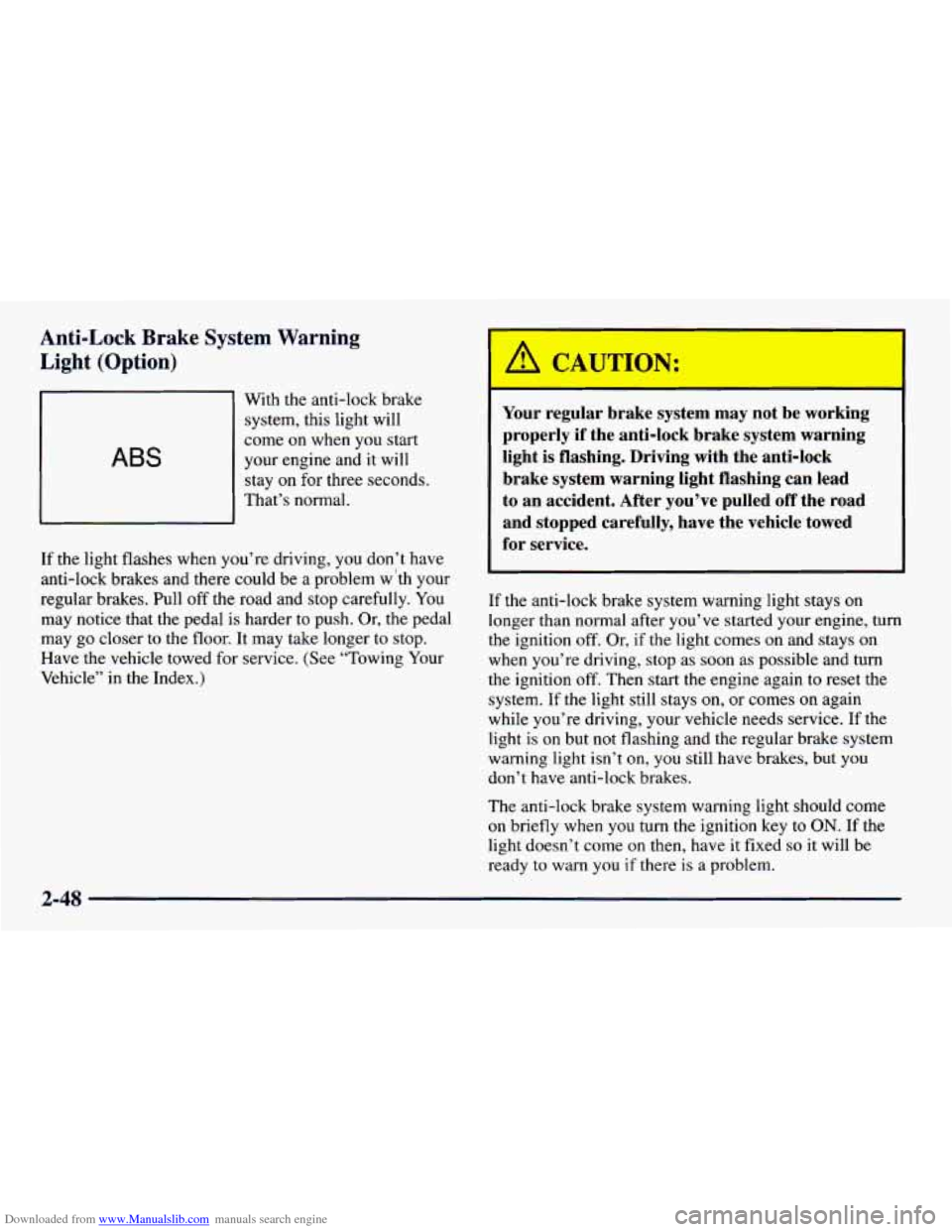
Downloaded from www.Manualslib.com manuals search engine Anti-Lock Brake System Warning
Light (Option)
ABS
With the anti-lock brake
system, this light will
come
on when you start
your engine and it will
stay on for three seconds.
That’s normal.
If the light flashes when you’re driving, you don’t have
anti-lock brakes and there could be a problem w ‘th your
regular brakes. Pull
off the road and stop carefully. You
may notice that the pedal is harder to push. Or, the pedal
may go closer to the floor. It may take longer to stop.
Have the vehicle towed for service. (See “Towing Your
Vehicle” in the Index.)
Your regular brake system may not be working
properly if the anti-lock brake system warning
light is flashing. Driving with the anti-lock
brake system warning light flashing can lead
to an accident. After you’ve pulled
off the road
and stopped carefully, have the vehicle towed
for service.
If the anti-lock brake system warning light stays on
longer than normal after you’ve started your engine, turn
the ignition
off. Or, if the light comes on and stays on
when you’re driving, stop as soon as possible and turn
the ignition
off. Then start the engine again to reset the
system. If the light still stays
on, or comes on again
while you’re driving, your vehicle needs service. If the
light is
on but not flashing and the regular brake system
warning light isn’t
on, you still have brakes, but you
don’t have anti-lock brakes.
The anti-lock brake system warning light should come
on briefly when you turn the ignition key to ON. If the
light doesn’t come
on then, have it fixed so it will be
ready to warn
you if there is a problem.
Page 159 of 364
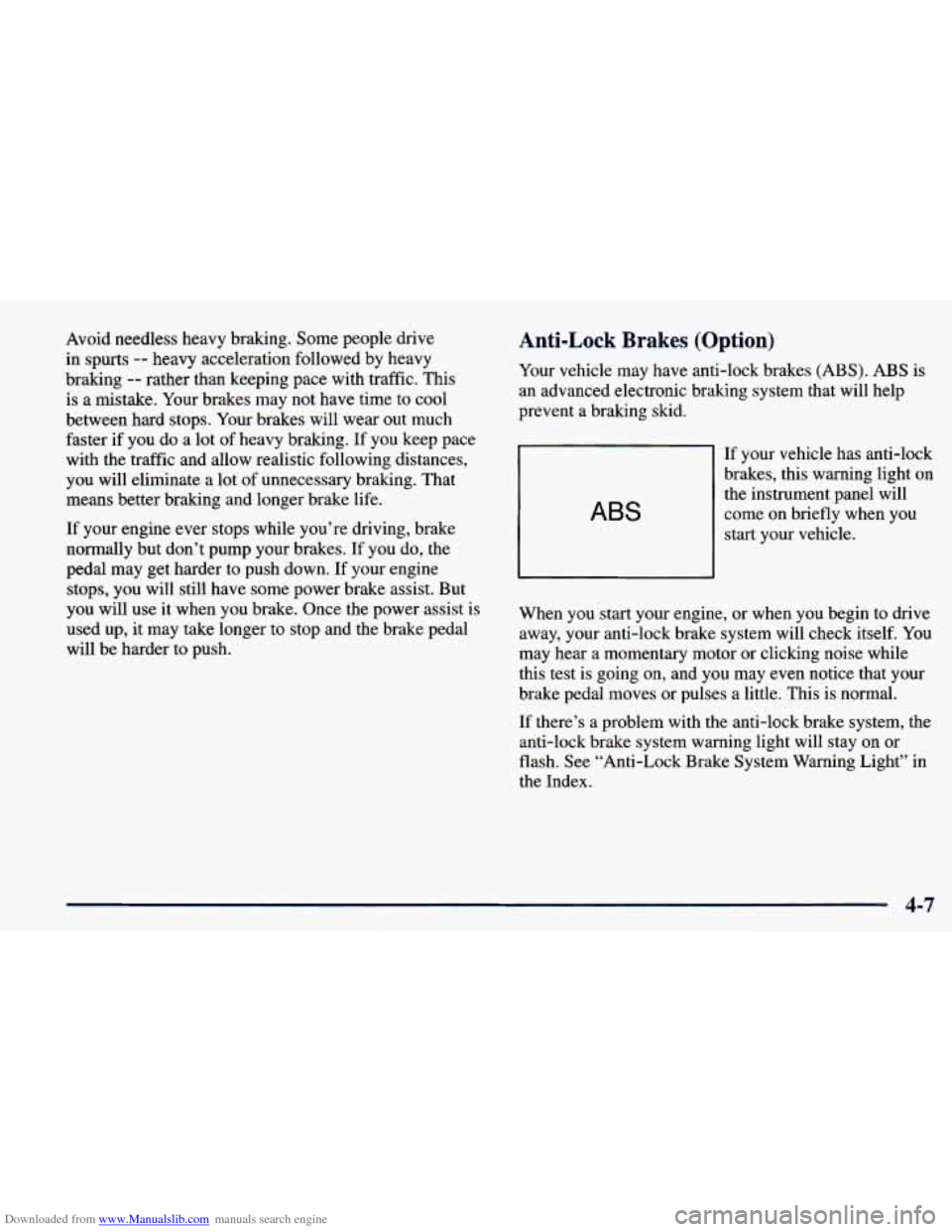
Downloaded from www.Manualslib.com manuals search engine Avoid needless heavy braking. Some people drive
in spurts
-- heavy acceleration followed by heavy
braking
-- rather than keeping pace with traffic. This
is a mistake. Your brakes may not have time to cool
between hard stops. Your brakes will
wear out much
faster if you do a lot of heavy braking. If you keep pace
with the traffic and allow realistic following distances, you will eliminate a lot of unnecessary braking. That
means better braking and longer brake life.
If your engine ever stops while you’re driving, brake
normally but don’t pump your brakes.
If you do, the
pedal may get harder to push down.
If your engine
stops, you will still have some power brake assist. But
you will use it when you brake. Once the power assist is
used up, it may take longer to stop and the brake pedal
will be harder to push.
Anti-Lock Brakes (Option)
Your vehicle may have anti-lock brakes (ABS). ABS is
an advanced electronic braking system that will help
prevent a braking slud.
ABS
If your vehicle has anti-lock
brakes, this warning light
on
the instrument panel will
come on briefly when you
start your vehicle.
When you start your engine, or when you begin to drive
away, your anti-lock brake system will check itself. You
may hear a momentary motor or clicking noise while
this test is going on, and you may even notice that your
brake pedal moves or pulses a little. This is normal.
If there’s a problem with
the anti-lock brake system, the
anti-lock brake system warning light will stay
on or
flash. See “Anti-Lock Brake System Warning Light” in
the Index.
4-7
Page 161 of 364

Downloaded from www.Manualslib.com manuals search engine Remember: Anti-lock doesn’t change the time you need
to get your foot up to the brake pedal or always decrease
stopping distance. If you get too close to the vehicle in
front of you, you won’t have time to apply your brakes
if that vehicle suddenly slows or stops. Always leave
enough room up ahead to stop, even though you have
anti-lock brakes.
Using
Anti-Lock
Don’t pump the brakes. Just hold the brake pedal down
firmly and let anti-lock work for you. You may feel a
slight brake pedal pulsation or notice some noise, but
this is normal.
Braking in Emergencies
At some time, nearly every driver gets into a situation
that requires hard braking. If
you have anti-lock, you can steer and brake at the
same time. However, if you don’t have anti-lock, your
first reaction
-- to hit the brake pedal hard and hold it
down
-- may be the wrong thing to do. Your wheels can
stop rolling. Once they do, the vehicle can’t respond to
your steering. Momentum will carry it in whatever
direction it was headed when the wheels stopped rolling.
That could be off the road, into the
very thing you were
trying to avoid, or into traffic.
If you don’t have anti-lock, use a “squeeze” braking
technique. This will give you maximum braking while
maintaining steering control. You do this by pushing on
the brake pedal with steadily increasing pressure.
In an emergency, you will probably want to squeeze
the brakes hard without locking the wheels.
If you
hear or feel the wheels sliding, ease off the brake pedal.
This will help you retain steering control.
(If you do
have anti-lock, it’s different: see “Anti-Lock Brakes”
in the Index.)
In many emergencies, steering can help you more than
even the very best braking.
4-9
Page 169 of 364
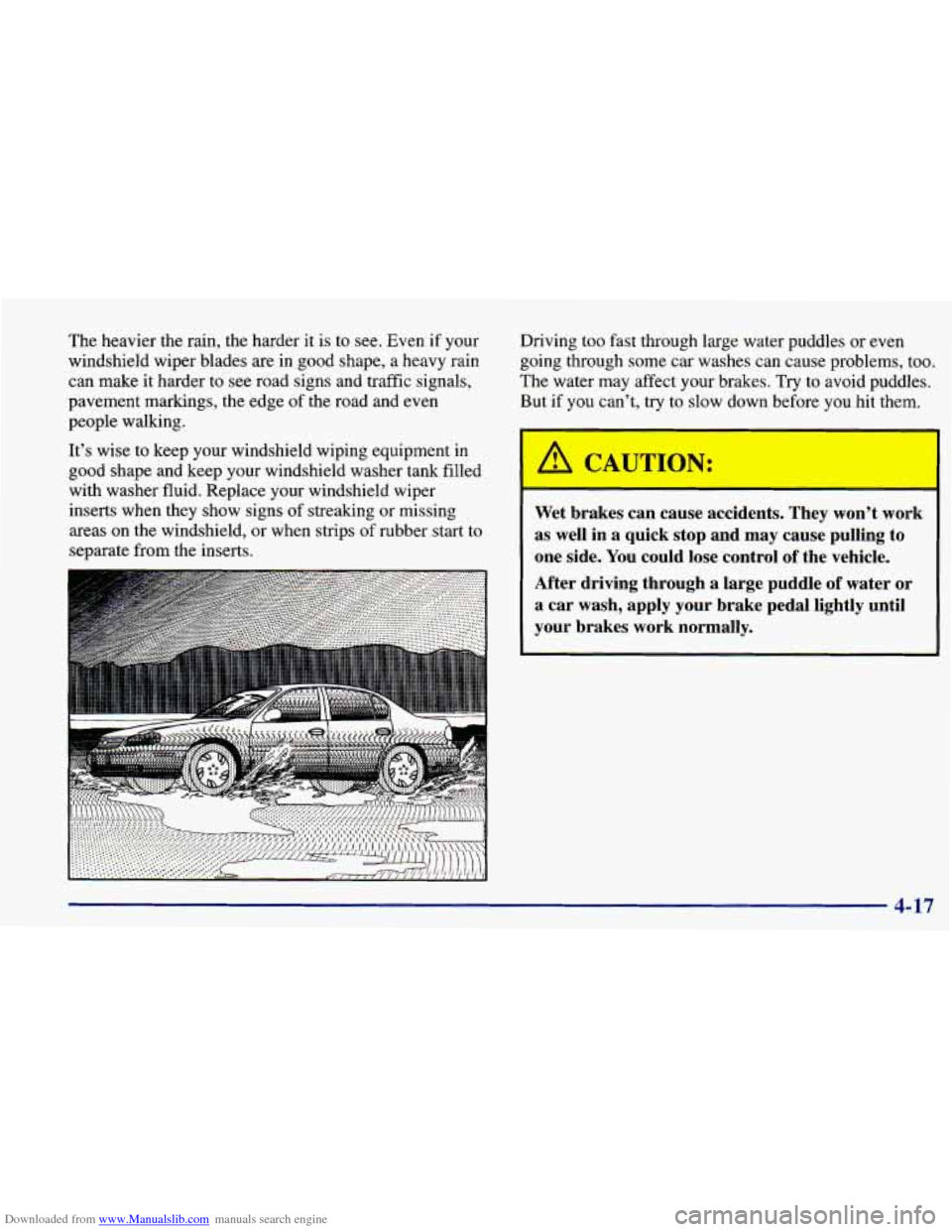
Downloaded from www.Manualslib.com manuals search engine The heavier the rain, the harder it is to see. Even if your
windshield wiper blades are in good shape, a heavy rain
can make it harder to
see road signs and traffic signals,
pavement markings, the edge of the road and even
people walking.
It’s wise to keep your windshield wiping equipment in
good shape and keep your windshield washer tank filled
with washer fluid. Replace your windshield wiper
inserts when they show signs
of streaking or missing
areas
on the windshield, or when strips of rubber start to
separate from the inserts. Driving too fast through large water puddles
or even
going through some
car washes can cause problems, too.
The water may affect your brakes. Try to avoid puddles.
But if you can’t, try to slow down before you hit them.
Wet brakes can cause accidents. They won’t work
as well in a quick stop and may cause pulling to
one side. You could lose control of the vehicle.
After driving through a large puddle of water or
a car wash, apply your brake pedal lightly until
your brakes work normally.
4-17
Page 255 of 364
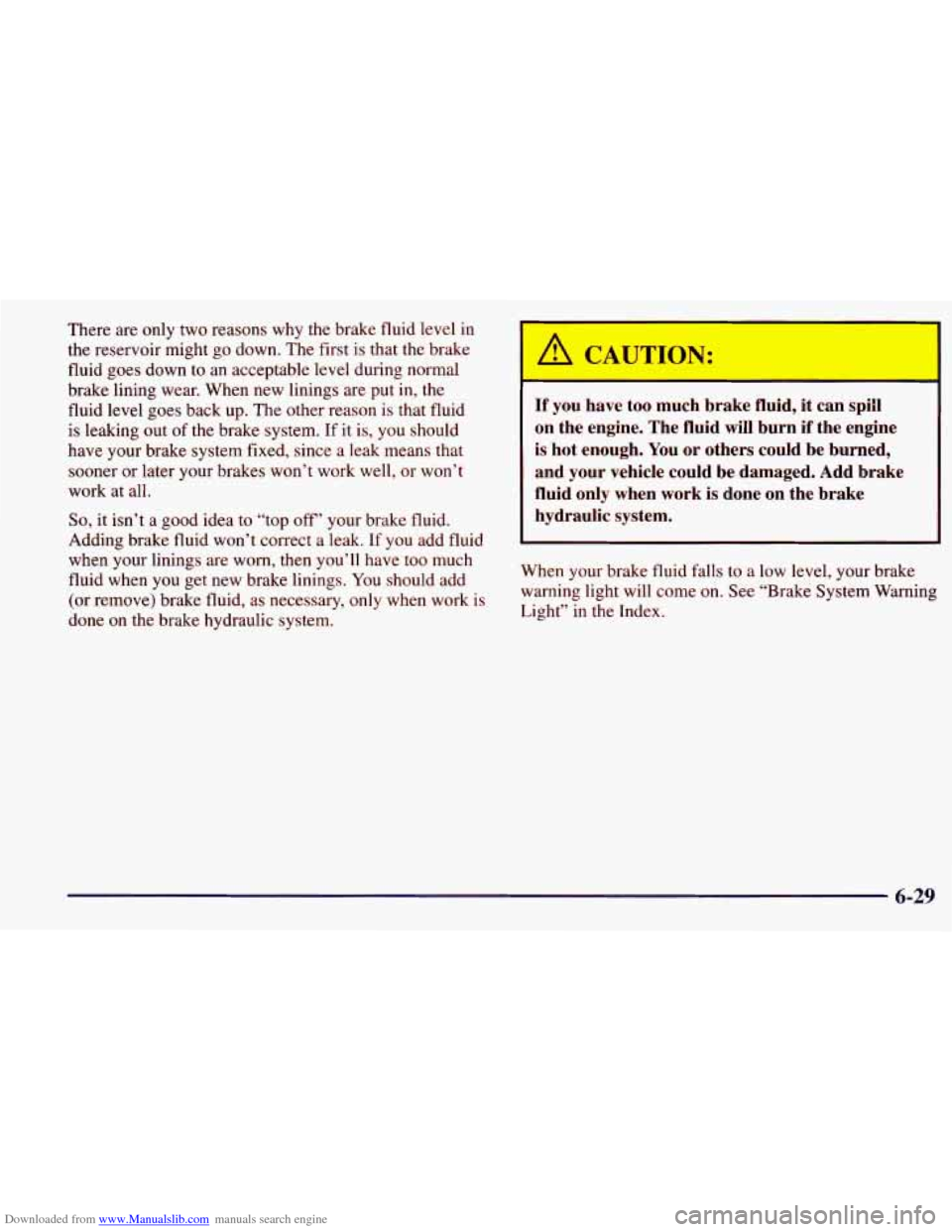
Downloaded from www.Manualslib.com manuals search engine There are only two reasons why the brake fluid level in
the reservoir might go down. The first is that the brake
fluid goes down to an acceptable level during normal
brake lining wear. When new linings are put in, the
fluid level goes back up. The other reason is that fluid
is leaking out
of the brake system. If it is, you should
have your brake system fixed, since a leak means that
sooner or later your brakes won’t work well, or won’t
work at all.
So, it isn’t a good idea to “top off’ your brake fluid.
Adding brake fluid won’t correct a leak.
If you add fluid
when your linings are worn, then you’ll have too much
fluid when you get new brake linings. You should add
(or remove) brake fluid, as necessary, only when work is
done on the brake hydraulic system.
A CAUTION:
If you have too much brake fluid, it can spill
on the engine. The fluid will burn if the engine
is hot enough. You
or others could be burned,
and your vehicle could be damaged. Add brake
fluid only when work is done on the brake
hydraulic system.
When your brake fluid falls to a low level, your brake
warning light will come on. See “Brake System Warning
Light” in the Index.
6-29
Page 257 of 364
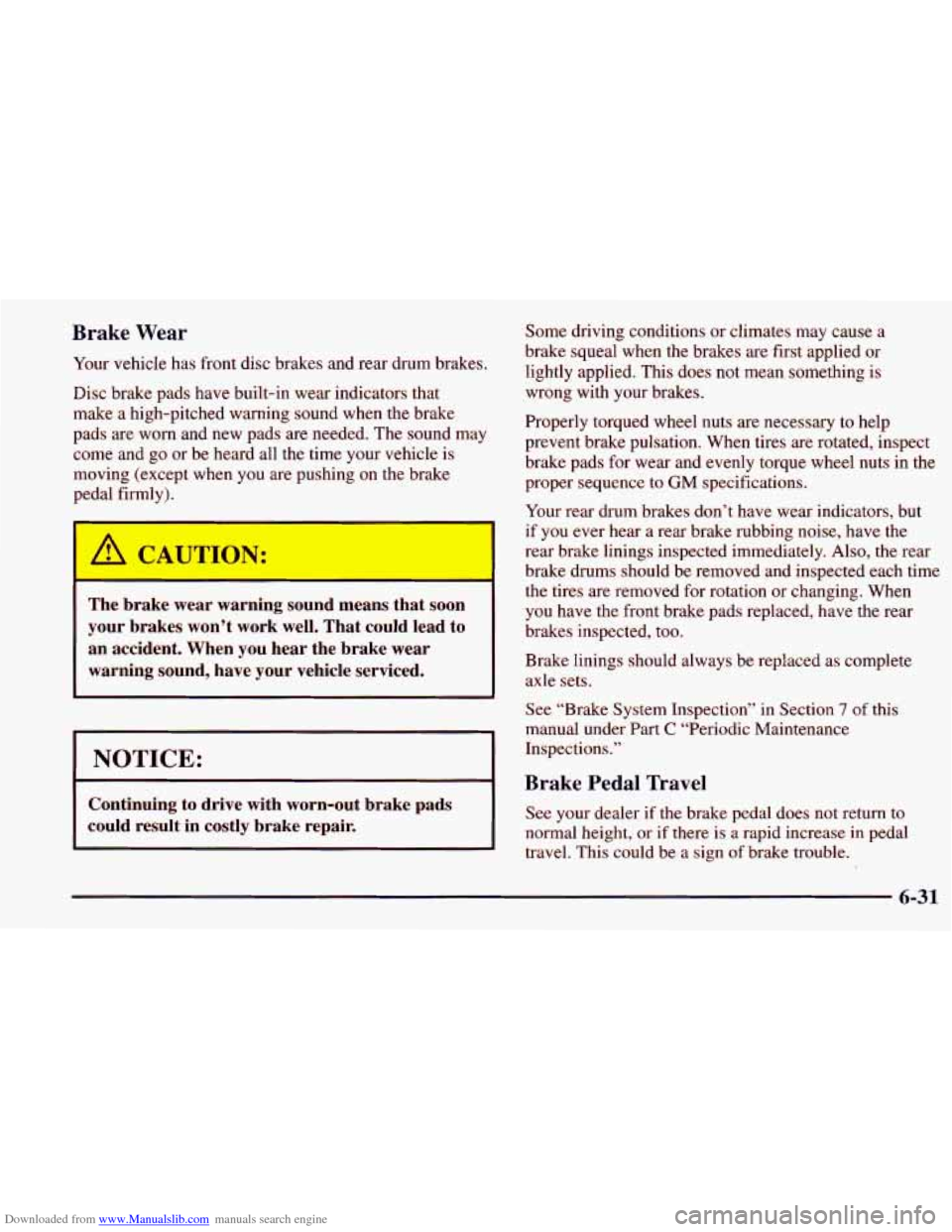
Downloaded from www.Manualslib.com manuals search engine Brake Wear
Your vehicle has front disc brakes and rear drum brakes.
Disc brake pads have built-in wear indicators that
make a high-pitched warning sound when the brake
pads are worn and new pads are needed. The sound may
come and
go or be heard all the time your vehicle is
moving (except when you are pushing on the brake pedal firmly).
The brake wear warning sound means that soon
your brakes won’t work well. That could lead to
an accident. When you hear the brake wear
warning sound, have your vehicle serviced.
I NOTICE:
I
Some driving conditions or climates may cause a
brake squeal when the brakes are first applied or
lightly applied. This does not mean something
is
wrong with your brakes.
Properly torqued wheel nuts are necessary to help
prevent brake pulsation. When tires are rotated, inspect
brake pads for wear and evenly torque wheel nuts in the
proper sequence to
GM specifications.
Your rear drum brakes don’t have wear indicators, but
if you ever hear a rear brake rubbing noise, have the
rear brake linings inspected immediately. Also, the rear
brake drums should be removed and inspected each time
the tires are removed for rotation or changing. When
you have the front brake pads replaced, have the rear
brakes inspected, too.
Brake linings should always be replaced as complete
axle sets.
Continuing to drive with worn-out brake pads
could result in costly brake repair.
See “Brake System Inspection” in Section 7 of this
manual under Part
C “Periodic Maintenance
Inspections.”
Brake Pedal Tra
See your dealer if the brake pedal does not return to
normal height, or if there is a rapid increase in pedal
travel. This could be a sign
of brake trouble.
Page 349 of 364

Downloaded from www.Manualslib.com manuals search engine 0 Section 9 Index
Adding Equipment to the Outside of Your Vehicle ..... 6-3
AirBag
....................................... 1-21
How Does it Restrain .......................... 1-27
How it Works ................................ 1-24
Location
.................................... 1-24
Readiness Light
......................... 1.23. 2.46
Servicing
................................... 1-29
What Makes
it Inflate .......................... 1-26
What Will You See After it Inflates
............... 1-27
When Should it Inflate
......................... 1-26
Aircleaner
............................... 6.16. 6.60
Air Conditioning Refrigerants
................ 6.59. 6.60
Alignment and Balance. Tire
...................... 6-42
Antenna
...................................... 3-17
Antifreeze
..................................... 6-23
Anti-Lock Brake System Warning Light
................ 2.48. 4.7
Brakes
...................................... 4-7
Appearancecare
............................... 6-44
Appearance Care Materials
....................... 6-52
Arbitration Program
.............................. 8-9
Ashtrays
...................................... 2-38
Audio Systems
.................................. 3-6
Automatic Light Control
......................... 2-33
Automatic Transaxle Fluid
....................................... 6-18
Air Conditioning
................................ 3-3
Fluid Level Check
............................ 7-38
Operation
................................... 2-14
Park Mechanism Check
........................ 7-41
Starting Your Engine
.......................... 2-13
Backing Up While Driving a Trailer
............... 4-35
Back-up Lamp Bulb Replacement
................. 6-36
Battery
....................................... 6-32
Jump Starting ................................. 5-3
Replacement. Keyless Entry
..................... 2-8
Warnings
................................ 5.3. 5.5
BBB Auto Line ................................. 8-9
Better Business Bureau Mediation
................... 8-9
Blizzard
...................................... 4-26
Brake Adjustment
.................................. 6-32
Fluid
....................................... 6-28
Master Cylinder
.............................. 6-28
Parking
..................................... 2-20
PedalTravel
................................. 6-31
Replacing System Parts
........................ 6-32
System Warning Light
......................... 2-47
Trailer
...................................... 4-34
Transaxle Shift Interlock
.................. 2.22. 7.40
Transaxle Shift Interlock Check
.................. 7-40
Wear
....................................... 6-31
9-1
Page 350 of 364

Downloaded from www.Manualslib.com manuals search engine Brakes. Anti-Lock ............................... 4-7
Braking in Emergencies
........................... 4-9
Break-In. New Vehicle
.......................... 2-11
Built-In Child Restraint
.......................... 1-36
Cleaning
.................................... 6-47
Removing the Child
........................... 1-44
Securing a Child
.............................. 1-37
Bulb Replacement
.............................. 6-33
........................................ Brdcing 4-6
BTSI
.................................... 2-22. 7-40
BTSICheck
................................... 7-40
..................................... Storing 1-45
Canadian Roadside Assistance
.................... 8-7
Capacities and Specifications
...................... 6-59
Carbon Monoxide
................ 2.9.2.24.4.27. 4.33
Cassette Deck Service
........................... 7-37
Cassette Tape Player
............................. 3-8
Cassette Tape Player Care ........................ 3- 15
Certification Label
.............................. 4-29
Chains. Tire
................................... 6-44
Changing a Hat Tire
............................. 5-23
Charging System Light
.......................... 2-46
Check Engine Light
............................. 2-49
Checking
Your Restraint Systems .................. 1-61
Chemical Paint Spotting
.......................... 6-51
Child Restraints
............ 1.33.1.36.1.48.1.54. 1.56
Securing in the Rear Seat
Position ................ 1-54
Securing
in the Right Front Seat Position .......... 1-56
Top Strap .................................. , . 1-53
Cigarette Lighter
............................... 2-38
Built-In
....,............................... l-36
Wheretoput ................................ l-53
Circuit Breakers and Fuses ....................... 6-54
Cleaning Cleaner. Air .............................. 6.16. 6.60
Aluminum Wheels
............................ 6-49
Built-in Child Restraint
........................ 6-47
Exterior LampsLenses
........................ 6-48
Glass Surfaces
............................... 6-47
Inside
of Your Vehicle ......................... 6-45
Instrument Panel
............................. 6-46
Interior Plastic Components
..................... 6-47
Outside
of Your Vehicle ........................ 6-48 .
Special Problems ............................. 6-46
Windshield and Wiper Blades
................... 6-48
Climate Control System
........................... 3-2
Clock, Setting the
................................ 3-6
Clutch Adjustment
.............................. 6-22
Clutch, Hydraulic
............................... 6-22
Column, Tilt
................................... 2-26
Comfort Controls
................................ 3-2
Fabric
...................................... 6-45
...................................... Stains 6-46
Tires
....................................... 6-50
Vinyl 6-46 .......................................
Compact Disc
Care
....................................... 3-17
Player 3-11 ......................................
Player Care .................................. 3-17
Compact Spare Tire
............................. 5-33
Console Storage Area
........................... 2-37
Control
of a Vehicle .............................. 4-6
Convex Outside Mirror
.......................... 2-36
Recovery
Tank .......................... 5-16, 5-17
Coolant ....................................... 6-23
9-2